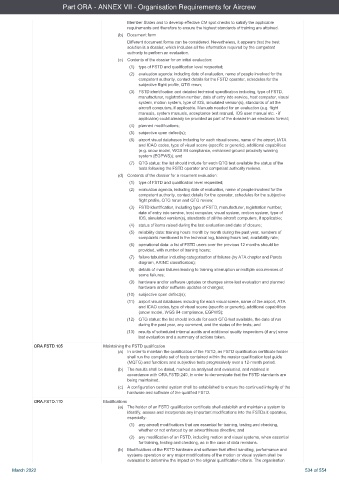Page 534 - UK AirCrew Regulations (Consolidated) March 2022
P. 534
Part ORA - ANNEX VII - Organisation Requirements for Aircrew
Member States and to develop effective CM spot checks to satisfy the applicable
requirements and therefore to ensure the highest standards of training are attained.
(b) Document form
Different document forms can be considered. Nevertheless, it appears that the best
solution is a dossier, which includes all the information required by the competent
authority to perform an evaluation.
(c) Contents of the dossier for an initial evaluation:
(1) type of FSTD and qualification level requested;
(2) evaluation agenda: including date of evaluation, name of people involved for the
competent authority, contact details for the FSTD operator, schedules for the
subjective flight profile, QTG rerun;
(3) FSTD identification and detailed technical specification including, type of FSTD,
manufacturer, registration number, date of entry into service, host computer, visual
system, motion system, type of IOS, simulated version(s), standards of all the
aircraft computers, if applicable. Manuals needed for an evaluation (e.g. flight
manuals, system manuals, acceptance test manual, IOS user manual etc. - if
applicable) could already be provided as part of the dossier in an electronic format;
(4) planned modifications;
(5) subjective open defect(s);
(6) airport visual databases including for each visual scene, name of the airport, IATA
and ICAO codes, type of visual scene (specific or generic), additional capabilities
(e.g. snow model, WGS 84 compliance, enhanced ground proximity warning
system (EGPWS)); and
(7) QTG status: the list should include for each QTG test available the status of the
tests following the FSTD operator and competent authority reviews.
(d) Contents of the dossier for a recurrent evaluation:
(1) type of FSTD and qualification level requested;
(2) evaluation agenda, including date of evaluation, name of people involved for the
competent authority, contact details for the operator, schedules for the subjective
flight profile, QTG rerun and QTG review;
(3) FSTD identification, including type of FSTD, manufacturer, registration number,
date of entry into service, host computer, visual system, motion system, type of
IOS, simulated version(s), standards of all the aircraft computers, if applicable;
(4) status of items raised during the last evaluation and date of closure;
(5) reliability data: training hours month by month during the past year, numbers of
complaints mentioned in the technical log, training hours lost, availability rate;
(6) operational data: a list of FSTD users over the previous 12 months should be
provided, with number of training hours;
(7) failure tabulation including categorisation of failures (by ATA chapter and Pareto
diagram, ARINC classification);
(8) details of main failures leading to training interruption or multiple occurrences of
some failures;
(9) hardware and/or software updates or changes since last evaluation and planned
hardware and/or software updates or changes;
(10) subjective open defect(s);
(11) airport visual databases including for each visual scene, name of the airport, ATA
and ICAO codes, type of visual scene (specific or generic), additional capabilities
(snow model, WGS 84 compliance, EGPWS);
(12) QTG status: the list should include for each QTG test available, the date of run
during the past year, any comment, and the status of the tests; and
(13) results of scheduled internal audits and additional quality inspections (if any) since
last evaluation and a summary of actions taken.
ORA.FSTD.105 Maintaining the FSTD qualification
(a) In order to maintain the qualification of the FSTD, an FSTD qualification certificate holder
shall run the complete set of tests contained within the master qualification test guide
(MQTG) and functions and subjective tests progressively over a 12-month period.
(b) The results shall be dated, marked as analysed and evaluated, and retained in
accordance with ORA.FSTD.240, in order to demonstrate that the FSTD standards are
being maintained.
(c) A configuration control system shall be established to ensure the continued integrity of the
hardware and software of the qualified FSTD.
ORA.FSTD.110 Modifications
(a) The holder of an FSTD qualification certificate shall establish and maintain a system to
identify, assess and incorporate any important modifications into the FSTDs it operates,
especially:
(1) any aircraft modifications that are essential for training, testing and checking,
whether or not enforced by an airworthiness directive; and
(2) any modification of an FSTD, including motion and visual systems, when essential
for training, testing and checking, as in the case of data revisions.
(b) Modifications of the FSTD hardware and software that affect handling, performance and
systems operation or any major modifications of the motion or visual system shall be
evaluated to determine the impact on the original qualification criteria. The organisation
March 2022 534 of 554

